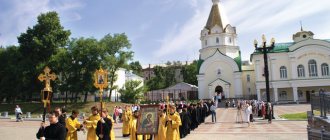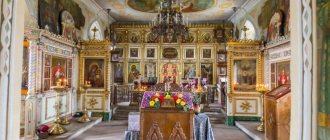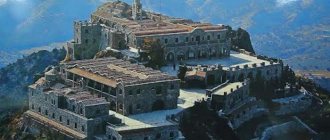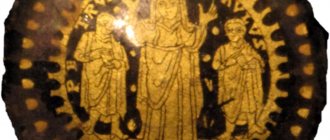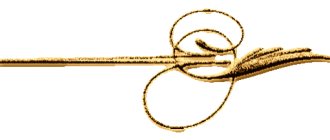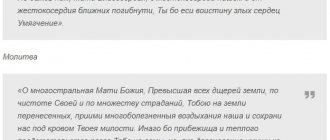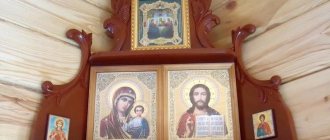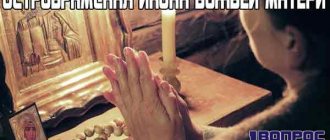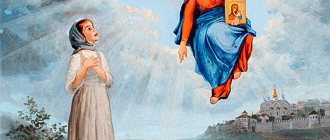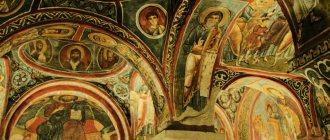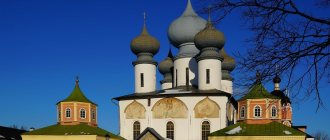The origin of the Konevskaya Icon of the Mother of God and its name
In the second half of the 14th century, a monk named Arseny lived in the Lisitsky Nativity of the Theotokos Monastery near Veliky Novgorod. In 1384, he asked for blessings and went to the Athos monastery - a holy place that is revered in Orthodoxy as one of the four earthly Destinations of the Mother of God.
On Athos, Arseny spent several years in continuous strict monastic asceticism: he prayed fervently, constantly fasted and worked hard - making copper utensils for the monastic brethren. With his ardent desire for spiritual achievement, he attracted the special attention of the abbot of the Athos monastery, the Monk John Zidon.
When Arseny prepared to return to his native land, the elder handed him a Greek icon of the Mother of God and predicted: “You will be the abbot of the new monastery.”
So in 1393, the Athonite icon of the Mother of God arrived in Veliky Novgorod. The monk Arseny accompanying her immediately upon arrival came to the Novgorod Archbishop John III, known for his wisdom and righteous deeds. The monk was eager to retire to the desert and found a monastery in honor of the Mother of God. The archbishop blessed him, and Arseny, taking with him the Athos icon, went north, along the Volkhov River, to Lake Ladoga.
- Konevets is a large sandy island washed up by the waters of Ladoga. The ship on which Arseny was sailing miraculously washed up on its shore twice. The monk considered this a sign from God and went ashore.
Stopping at Konevets, Arseny built his cell here, and then the Church of the Nativity of the Blessed Virgin Mary. With his ascetic life, he began to attract disciples to the island, and soon the prophecy of Abbot John Zidon came true - a new monastery grew, of which the Monk Arseny became the rector. And based on the location of this monastery, both he himself and the Mother of God icon he revered began to be called Konevsky.
- In 1547, the Venerable Arseny Konevsky was canonized as a saint. All icons with his face are certainly accompanied by an image of the Konevskaya Icon of the Mother of God, which the monk did not part with until the end of his life.
Protection and protection of Konevskaya land
None of the inhabitants of the island was faced with the question, how does the Konevskaya Icon of the Mother of God help a person? Yes, in everything, and all the children and adults in the area knew about it.
More than once she saved these lands from various troubles and misfortunes, and therefore began to be revered as the protector and patroness of Konevsky Island and the surrounding lands. And even when the Swedes attacked Karelia, the Mother of God did not turn away from people, but had mercy, saved and protected. During the same attack, an attempt was made on the icon of the Mother of God itself. The enemies, not ashamed of either God or the Tsar, wanted to plunder the monastery and destroy it. Incredibly, at one moment, from the sky, in which there were no clouds or clouds, a strong roar was heard and lightning flashed - a storm was beginning. The ice around Konevsky Island cracked and broke overnight, so the Swedes simply could not get to the island and carry out their plans.
This event became another indisputable fact of the intercession of the Most Holy Theotokos.
Iconography and meaning of the Konevskaya Icon of the Mother of God
The plot and composition of the Konevskaya Icon of the Mother of God are unique. Despite the fact that it is usually attributed to the traditional iconographic type of Hodegetria, it differs from it in many key details:
- The position of the right hand of the Virgin Mary. Hodegetria (Pointing the Way) almost always holds her right hand to her chest, palm facing up. This gesture is both pleading and pointing to the Christ Child as the path of salvation. On the Konevskaya Icon of the Mother of God, the right hand of the Mother of God rests on the scarlet himation of Christ.
- Snow-white bedspread. This element of clothing is absent from traditional images of Hodegetria. On the Konevskaya icon it covers the head of the Mother of God under the maforium, goes down to the chest and then is thrown over the right shoulder.
- Lack of blessing gestures. For icons belonging to the Hodegetria type, this detail is required - the fingers of the right hand of the Infant God are folded into two fingers. On the Konevskaya icon, in the right hand of Christ there is a thread stretching to a dove. There is no thread on some of the icons, but with his right hand the Child holds the folds of the Virgin Mary’s white veil.
- Pigeon. The detail that gave the Konevskaya icon its second name - Golubitskaya. The Infant Christ holds a white dove on his left hand.
The white dove is a well-known symbol of the Holy Spirit who descended on Christ during his baptism in the Jordan. It is also found on icons depicting the Annunciation of the Blessed Virgin Mary.
Summarizing the symbolism of the Konevskaya icon, we can come closer to understanding its meaning:
“Here He is, the Son of the Eternal Father, releasing the dove from the “Ark Gilded by the Spirit” (Akathist to the Mother of God) - from the depths of the Virgin Mother who bore Him under the heart, here He is the new Noah. Rest for the feet of the dove (Gen. 8:9) - right here, next to the hand of the Son, which He will “give to the wounds.”
He Himself is the very Sacrifice that allows the wings of the Spirit to spread over the waters surrounding the island - both Konevets and any island, for He, the Son of the Father, is the hope of the islands (Is. 42:4). He is the hope of His Church throughout the entire universe, and the hope of every soul, “which is the Church in every nation” (schm. Irenaeus of Lyons).
The veil of the Mother of God, who is the image of the Church, is white, like the flesh of the Risen Christ permeated by the Spirit, woven together by the Spirit in the womb of the Mother of God.”
O. Shulcheva-Jarman, author of articles and books on theology and Christian history of medicine
- On some later versions of the Konevskaya Icon of the Mother of God, the Infant God holds two doves, but on the Athos original there is only one dove. The original also has a second side - on its reverse is written the image of the Savior Not Made by Hands.
Prayers
Troparion, tone 1
Rising to us, like a luminous sun from the east in splendor, / Thy icon, Lady, / illuminating miracles with a glorious radiance / of all who come to her with faith and love / and who pray fervently to Thy greatness, for Thy Son and God./ Glory to God, who gave us this by Arseny, / glory to him who returned from Novagrad, / glory to him who heals all through it.
Kontakion, tone 8
The Most Illustrious Mother of the Most High calls us to the hymn / of Her image with the coming from Novagrad / and excites us with the vision of feat, / to defeat the opposing forces, / and to Her, as our guilty joy, sing: / Rejoice, Unmarried Bride.
Prayer
Oh, All-Merciful Lady, Virgin Mary! Listen to my humble prayer, and hear the voice of Your now approaching image with contrition. We know, O my Creator Mother, that You are the shameless intercession of Christians and the immutable intercession to the Creator. We know this too, as my Iniquity has surpassed my head, and as a heavy burden weighs heavily on me, and I am no longer worthy to see the heights of heaven, to look below the Throne of the glory of Your Son and our God, but worthy of torment and eternal condemnation. For this reason, I fall down to You (along with those who are coming together), I ask You tenderly, I cry to You with tears: make Your most motherly prayer to Him, so that He will not reject us, sinners, from His presence: but as He is merciful, may He forgive us our sins, freely and involuntary, instructing us on the path of salvation, and strengthening us with power from above to keep the commandments of His saints. May he protect us from the temptations of the world, from sinful lusts, from the snares of the devil, and from the attacks of visible enemies. May He bless the works of our hands, giving to this monastery and to every city and country an abundance of earthly blessings: May He create for us good and serene days: may He protect His holy Church with peace, and may He unite the one who is apart, for the Lord is good, Long-suffering and Much-Merciful, from all creation with the Father and the Holy Spirit, glorified forever and ever. Amen.
History of the Konevskaya Icon of the Mother of God and the Konevskaya Nativity of the Theotokos Monastery
Konevets Island was named so because of the huge granite boulder located on it in the shape of a horse's head - the so-called Horse-stone. At that time it was one of the Finno-Ugric sanctuaries, and local residents performed pagan rituals with sacrifices there. Arseny learned about this from a certain fisherman named Philip.
Having visited the Horse-Stone, Arseny considered it an eerie place, “surrounded by demonic horror more than a dense forest.” After spending the night in continuous prayer, in the morning he took the icon of the Mother of God, walked around the pagan sanctuary with it and sprinkled the stone with holy water. According to legend, at that same moment a countless horde of black ravens flew out of the stone and flew away to the opposite shore of the island, where they disappeared. Surprisingly, on the same day, all the snakes left the island.
- The legendary Horse-Stone has survived to this day. In memory of the miracle of expelling demons in 1895, the clock of St. Arseny was built right on top of the boulder.
The icon of the Mother of God could now forever remain on the island of Konevets, in the temple built for her, if not for historical vicissitudes. The Monk Arseny died in 1447, and after that the Konevetsky Monastery was destroyed several times. Twice (in 1577 and 1610) the border island was captured by the Swedes, and the monastery inhabitants, taking the icon, waited out the raids near Novgorod, in the Derevyanitsky Resurrection Monastery.
The next devastation occurred in the 20th century. The waves of the Soviet-Finnish and then the Second World War swept through the monastery. As a result, the last nine Konevo monks, after long wanderings, together with the holy image of the Konevo Mother of God, arrived at the New Valaam Monastery in the town of Papinniemi in Finland.
- In Soviet times, a military naval unit and barracks were located within the monastery walls. However, now the Konevsky Nativity of the Theotokos Monastery has been restored and is a place of pilgrimage for Orthodox Christians from all over the world.
Exorcism of demons and triumph of the Mother of God
Arseny knew about the miraculous power of the icon from the time when he lived on Athos. And here, in a monastery on Russian soil, he was not the only one who felt the unknown grace and tranquility emanating from the icon.
Before the solemn arrival of the icon on the lands of Russia, almost all the people living on the island professed a pagan religion and worshiped the forces of nature, and in the center of the island there was the main object of worship - a sacred stone idol. Arseny, armed with the word of God and taking in his hands the icon of the Konevskaya Mother of God, walked with a religious procession throughout the island and stopped at the pagan stone idol. Arseny stood in this place and with all his heart, with all his soul, prayed to the Lord God.
The power of the shrine is great: at one moment the stone ceased to carry the pagan power, and the demons that escaped from it became black crows and scattered in all directions. Since then, the previously main pagan idol has become the main symbol of the revival of Orthodoxy on the Konevskaya land.
Current location of the original Konevskaya Icon of the Mother of God
Unfortunately, the original Konevskaya Icon of the Mother of God, which belonged to the Venerable Arseny himself, remained in the New Valaam Monastery in Finland. In the Nativity of the Mother of God Monastery on Konevets, only copies of this miraculous image are kept, including one accurate, measured one.
Recently, specialist restorers of the cathedral church of the New Valaam Monastery cleared the ancient face of the Mother of God from later layers. The restored shrine is carefully cared for.
- From time to time, the original of the miraculous Konevskaya Icon of the Mother of God travels throughout the Orthodox world. In particular, sometimes he is brought to Russia - to the land that glorified him. However, there is no talk of a complete return of the relic to Konevets.
Miracles performed through the image of the Mother of God Konevskaya
In addition to the incident described in the life of St. Arseny with the expulsion of demons from the Horse-Stone, numerous miracles of myrrh-flowing and healing are associated with the image of the Konevskaya Mother of God. Moreover, not only the original, but also some lists are capable of exuding such grace.
One of the modern cases of miraculous healing was recorded in the village of Sapernoye, located on the Karelian Isthmus. Here, in the mid-90s, a small wooden church was erected, in which a copy of the Konevskaya Icon of the Mother of God was placed. In 1996, it began to flow myrrh.
One of the parishioners of the temple suffered from a severe form of viral uveitis, in which the uvea of the eyes becomes inflamed and blindness often develops. During the service, the priest decided to anoint the patient’s eyes with the sacred oil drained from the icon. This led to recovery so quickly that it surprised the attending physician.
Requests for healing before the miraculous icon
The Akathist to the Konevskaya Icon of the Mother of God is read on a variety of occasions. The Mother of God does not leave without help all those who sincerely ask for her help, especially those who turn to her to be healed of demons, common eye diseases, blindness, drug addiction and paralysis. When it is not possible to read the akathist or you do not know how, you can turn to the Mother of God with sincere prayer from the bottom of your heart in your own words.
In such cases, it is important to remember that in prayer before God it is not the words and correct pronunciation that are important, but purity of thoughts, repentance, and sincerity of the request. All believers must understand that people may not understand our words, but not God. God always understands everything, but do we understand him? When the need arises, you must pray as best you can. Prayer to the Mother of God has enormous power and is capable of working miracles.
Both parishioners and pastors know that the Konevskaya Icon of the Mother of God is capable of working miracles, and this is indeed so!
How does the Konevskaya Icon of the Mother of God help?
Orthodox believers turn to the holy image of the Konevskaya Mother of God with a variety of hardships. But judging by numerous evidence, this icon still has its own special “specificity”:
“I suffered from chronic chalazion for many, many years. I’m tired of counting how many times my eyelids have been opened and cleaned. On the advice of one old woman, she went to St. Petersburg to the courtyard of the Konevsky monastery. In the temple of the Konevskaya Icon of the Mother of God, she held a service and venerated the icon, fervently praying for recovery. I can hardly believe it myself, but for three years now the chalazion has not bothered me, although previously there were exacerbations every autumn and spring!”
Maria, Leningrad region
Thus, we can note the special grace inherent in this icon for healing eye diseases. Cases of help in getting rid of bad addictions and obsessions are also often mentioned.
